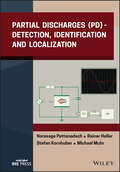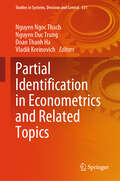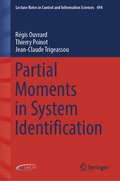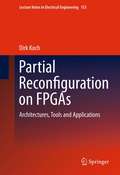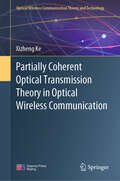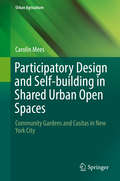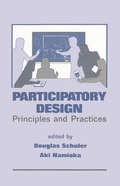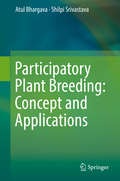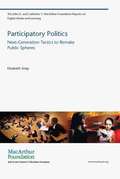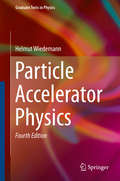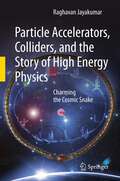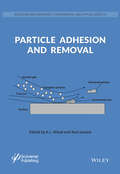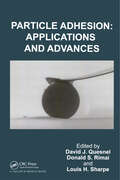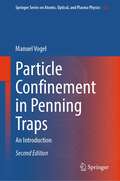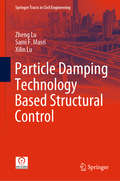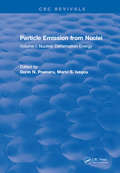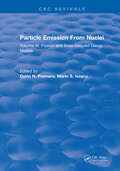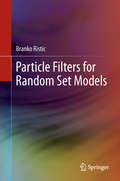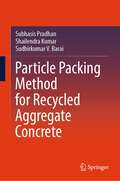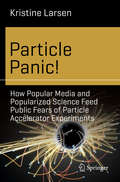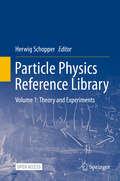- Table View
- List View
Partial Discharges: Detection, Identification and Localization (IEEE Press)
by Norasage Pattanadech Michael Muhr Rainer Haller Stefan KornhuberPARTIAL DISCHARGES (PD) — DETECTION, IDENTIFICATION AND LOCALIZATION Explore state-of-the-art partial discharge measurement techniques In Partial Discharges (PD) — Detection, Identification and Localization, a team of distinguished electrical engineers delivers a comprehensive treatment of the behavior, modeling, measurement, monitoring, localization, and evaluation of partial discharges. It includes coverage of all major advancements in the field that have occurred over the last few decades. It also discusses partial discharge phenomena, detection methods, and strategies for analyzing and processing collected data. Mechanisms of insulation failure are explored, as is the denoising of partial discharge measurement data and the localization of partial discharge in large, high-voltage equipment. Non-electric principles and procedures are discussed, and the book offers a variety of tables, figures, and photographs to illustrate the concepts discussed within. Partial Discharges(PD) also provides: A thorough introduction to the physical behavior of partial discharges, including their causes and classification Comprehensive modeling of partial discharge behavior, including classical and dipole discharges Practical discussions of the measurement of partial discharges, including the electrical method, partial discharge decoupling, and pre- and post-processing of partial discharges In-depth examinations of the monitoring of partial discharge behavior, including methods and realization Perfect for electrical engineers engaged in electrical power engineering, Partial Discharges (PD) will also earn a place in the libraries of research and development specialists employed in the manufacturing, quality testing and operation of electrical systems.
Partial Identification in Econometrics and Related Topics (Studies in Systems, Decision and Control #531)
by Vladik Kreinovich Nguyen Ngoc Thach Nguyen Duc Trung Doan Thanh HaThis book covers data processing techniques, with economic and financial application being the unifying theme. To make proper investments in economy, the authors need to have a good understanding of the future trends: how will demand change, how will prices change, etc. In general, in science, the usual way to make predictions is: to identify a model that best fits the current dynamics, and to use this model to predict the future behavior. In many practical situations—especially in economics—our past experiences are limited. As a result, the authors can only achieve a partial identification. It is therefore important to be able to make predictions based on such partially identified models—which is the main focus of this book. This book emphasizes partial identification techniques, but it also describes and uses other econometric techniques, ranging from more traditional statistical techniques to more innovative ones such as game-theoretic approach, interval techniques, and machine learning. Applications range from general analysis of GDP growth, stock market, and consumer prices to analysis of specific sectors of economics (credit and banking, energy, health, labor, tourism, international trade) to specific issues affecting economy such as ecology, national culture, government regulations, and the existence of shadow economy. This book shows what has been achieved, but even more important are remaining open problems. The authors hope that this book will: inspire practitioners to learn how to apply state-of-the-art techniques, especially techniques of optimal transport statistics, to economic and financial problems, andinspire researchers to further improve the existing techniques and to come up with new techniques for studying economic and financial phenomena. The authors want to thank all the authors for their contributions and all anonymous referees for their thorough analysis and helpful comments. The publication of this book—and organization of the conference at which these papers were presented—was supported: by the Ho Chi Minh University of Banking (HUB), Vietnam, and by the Vingroup Innovation Foundation (VINIF). The authors thank the leadership and staff of HUB and VINIF for providing crucial support.
Partial Moments in System Identification (Lecture Notes in Control and Information Sciences #494)
by Jean-Claude Trigeassou Régis Ouvrard Thierry PoinotThis book provides a complete round-up of developments concerned with the application of partial moments in system identification and data-driven modelling; it captures the essence of work carried out at the Laboratoire d'Informatique et d'Automatique pour les Systèmes for more than 40 years. The book begins with introductory material, describing both the mathematical tools associated with partial moments and reinitialized partial moments and an example demonstrating their use. The authors then proceed to show how these tools can be used for the identification of continuous-time linear models, discrete-time linear models, continuous-time linear state-space models, linear parameter-varying models and multidimensional models based on partial differential equations. The properties and performances of each of these approaches are presented. The analogy with algebraic approaches is proved, thus opening perspectives for extension to other fields. The text removes some long-standing limitations on the implementation of partial-moment-based tools in system identification. This book is of interest to researchers and postgraduates studying system identification, control theory, applied mathematics and computer science. It is also useful for engineers working on industrial applications of the parametric estimation of mathematical models.
Partial Reconfiguration on FPGAs
by Dirk KochThis is the first book to focus on designing run-time reconfigurable systems on FPGAs, in order to gain resource and power efficiency, as well as to improve speed. Case studies in partial reconfiguration guide readers through the FPGA jungle, straight toward a working system. The discussion of partial reconfiguration is comprehensive and practical, with models introduced together with methods to implement efficiently the corresponding systems. Coverage includes concepts for partial module integration and corresponding communication architectures, floorplanning of the on-FPGA resources, physical implementation aspects starting from constraining primitive placement and routing all the way down to the bitstream required to configure the FPGA, and verification of reconfigurable systems.
Partially Coherent Optical Transmission Theory in Optical Wireless Communication (Optical Wireless Communication Theory and Technology)
by Xizheng KeThis book introduces the theory and research methods of partially coherent optical, points out the significance of this study, analyzes the basic theories involved in partially coherent light, and explains the complete coherence of laser is not a necessary condition for good directivity, and partially spatially coherent optical sources can also produce the same far-field intensity distribution as lasers. This type of beam with good directivity but only partial spatial coherence is called a Gaussian Schell model beam, which can be used as a physical model to describe multimode lasers under certain conditions. This book is applicable to the large number of engineers and technicians involved in wireless optical communication and college teachers. It can also be used as a teaching material for graduate students and senior undergraduates in related fields.
Participant Handbook - Data Entry Operator (Divyangjan)
by Skill Council for Persons with DisabilityThe Participant Handbook - Data Entry Operator (Divyangjan) is a comprehensive guide designed to provide skill-based training for individuals with disabilities, focusing on the role of Domestic Data Entry Operators within the IT-ITeS sector. It aligns with the National Occupational Standards and offers structured learning through a modular approach. Covering essential aspects like data entry processes, software requirements, troubleshooting, and employability skills, the handbook emphasizes accuracy, professionalism, and error mitigation in data handling. It also incorporates guidelines for leveraging automation technologies such as OCR and AI to enhance efficiency, while addressing the unique needs of participants through tailored content for various disabilities.
Participatory Action Research in Natural Resource Management: A Critque of the Method Based on Five Years' Experience in the Transamozonica Region of Brazil
by Carl F. Jordan Christian CastellanetThis work evaluates the merits of a widely-used approach to natural resource management, participatory action research (PAR), an approach to resource management that strives to link researchers with farmers and other local residents whose lives are effected by long-range conservation programmes. The authors begin the book with the history of PAR, and then use a variety of case studies that chronicle sustainable development efforts in Brazil. They evaluate the strengths and weaknesses of these efforts and suggest specific ways to improve on future PAR efforts.
Participatory Design and Self-building in Shared Urban Open Spaces: Community Gardens And Casitas In New York City (Urban Agriculture Ser.)
by Carolin MeesThe book investigates the development of community gardens with self-built structures, which have existed as a shared public open space land use form in New York City’s low-come neighborhoods like the South Bronx since the 1970s. These gardens have continued to be part of the urban landscape until today, despite conflicting land use interests, changing residents groups and contradictory city planning. Both community gardens and self-built structures are created in a participatory design and self-built effort by urban residents and are an expression of the individual gardeners’ preferences, their cultural background and the decisions made by the managing residents’ group in regards to the needs of their neighborhood. Ultimately community gardens with self-built structures are an expression of the people’s will to commonly use this land for open and enclosed structures next to their homes in the city and need to be included in future urban planning.
Participatory Design: Principles and Practices
by DOUGLAS SCHULER AND AKI NAMIOKAThe voices in this collection are primarily those of researchers and developers concerned with bringing knowledge of technological possibilities to bear on informed and effective system design. Their efforts are distinguished from many previous writings on system development by their central and abiding reliance on direct and continuous interaction with those who are the ultimate arbiters of system adequacy; namely, those who will use the technology in their everyday lives and work. A key issue throughout is the question of who does what to whom: whose interests are at stake, who initiates action and for what reason, who defines the problem and who decides that there is one. The papers presented follow in the footsteps of a small but growing international community of scholars and practitioners of participatory systems design. Many of the original European perspectives are represented here as well as some new and distinctively American approaches. The collection is characterized by a rich and diverse set of perspectives and experiences that, despite their differences, share a distinctive spirit and direction -- a more humane, creative, and effective relationship between those involved in technology's design and use, and between technology and the human activities that motivate the technology.
Participatory Plant Breeding: Concept and Applications
by Shilpi Srivastava Atul BhargavaPlant breeding has played a significant role in the development of human civilizations. Conventional plant breeding has significantly improved crop yield by genetically manipulating agronomically important traits. However, it has often been criticized for ignoring indigenous germplasm, failing to address the needs of the marginal and the poor farmers, and emphasizing selection for broad instead of local adaptation. Participatory plant breeding (PPB) is the process by which the producers and other stakeholders are actively involved in a plant-breeding programme, with opportunities to make decisions throughout. The Working Group on Participatory Plant Breeding (PPBwg) was established in 1996 under the framework of the Consultative Group on International Agricultural Research (CGIAR). Research in PPB can promote informed participation and trust in research among consumers and producers, and in recent years, PPB has had a significant impact on food production by quickly and cost-effectively producing improved crop varieties. At the same time, there has been significant research in the area. PPB offers significant advantages that are particularly relevant to developing countries where large investments in plant breeding have not led to increased production, especially in the marginal environments. In addition to the economic benefits, participatory research has a number of psychological, moral, and ethical benefits, which are the consequence of a progressive empowerment of the farming communities. PPB can empower groups such as women or less well-off farmers that are traditionally left out of the development process.This book explores the potential of PPB in the coming decades. The topic is more relevant since international breeding efforts for major crops are aimed at decentralizing local breeding methods to better incorporate the perspective of end users into the varietal development process. The first book incorporating the upcoming research on this novel breeding approach, it reviews the important tools and applications of PPB in an easy-to-read, succinct format, with illustrations to clarify these complex topics. It provides readers with a basic idea of participatory plant breeding as well as advances in the field and insights into the future to facilitate the successful integration of farmers into breeding programmes.This book is a valuable reference resource for agriculturists, agricultural advisers, policy makers, NGOs, post-doctoral students and scientists in agriculture, horticulture, forestry and botany.
Participatory Politics
by Elisabeth SoepAlthough they may disavow politics as such, civic-minded young people use every means and media at their disposal to carry out the basic tasks of citizenship. Through a mix of face-to-face and digital methods, they deliberate on important issues and debate with peers and powerbrokers, redefining some key dynamics that govern civic life in the process. In Participatory Politics, Elisabeth Soep examines the specific tactics used by young people as they experiment with civic engagement. Drawing on her scholarly research and on her work as a media producer and educator, Soep identifies five tactics that are part of effective, equitable participatory politics among young people: Pivot Your Public (mobilizing civic capacity within popular culture engagements); Create Content Worlds (using inventive and interactive storytelling that sparks sharing); Forage for Information in public data archives; Code Up (using computational thinking to design tools, platforms, and spaces for public good); and Hide and Seek (protecting privacy and information sources). After describing these tactics as they manifest themselves in a range of youth-driven activities -- from the runaway spread of the video Kony 2012 to community hackathons -- Soep discusses concrete ideas for cultivating the new literacies that will enable young people to participate in public life. She goes on to consider some risks associated with these participatory tactics, including simplification and sensationalism, and ways to avoid them, and concludes with implications for future research and practice.
Particle Accelerator Physics: Basic Principles And Linear Beam Dynamics (Graduate Texts in Physics)
by Helmut WiedemannThis book by Helmut Wiedemann is a well-established, classic text, providing an in-depth and comprehensive introduction to the field of high-energy particle acceleration and beam dynamics.The present 4th edition has been significantly revised, updated and expanded. The newly conceived Part I is an elementary introduction to the subject matter for undergraduate students. Part II gathers the basic tools in preparation of a more advanced treatment, summarizing the essentials of electrostatics and electrodynamics as well as of particle dynamics in electromagnetic fields. Part III is an extensive primer in beam dynamics, followed, in Part IV, by an introduction and description of the main beam parameters and including a new chapter on beam emittance and lattice design. Part V is devoted to the treatment of perturbations in beam dynamics. Part VI then discusses the details of charged particle acceleration. Parts VII and VIII introduce the more advanced topics of coupled beam dynamics and describe very intense beams – a number of additional beam instabilities are introduced and reviewed in this new edition. Part IX is an exhaustive treatment of radiation from accelerated charges and introduces important sources of coherent radiation such as synchrotrons and free-electron lasers. The appendices at the end of the book gather useful mathematical and physical formulae, parameters and units. Solutions to many end-of-chapter problems are given.This textbook is suitable for an intensive two-semester course starting at the senior undergraduate level.
Particle Accelerators, Colliders, and the Story of High Energy Physics
by Raghavan JayakumarThe Nordic mythological Cosmic Serpent, Ouroboros, is said to be coiled in the depths of the sea, surrounding the Earth with its tail in its mouth. In physics, this snake is a metaphor for the Universe, where the head, symbolizing the largest entity - the Cosmos - is one with the tail, symbolizing the smallest - the fundamental particle. Particle accelerators, colliders and detectors are built by physicists and engineers to uncover the nature of the Universe while discovering its building blocks. "Charming the Cosmic Snake" takes the readers through the science behind these experimental machines: the physics principles that each stage of the development of particle accelerators helped to reveal, and the particles they helped to discover. The book culminates with a description of the Large Hadron Collider, one of the world's largest and most complex machines operating in a 27-km circumference tunnel near Geneva. That collider may prove or disprove many of our basic theories about the nature of matter. The book provides the material honestly without misrepresenting the science for the sake of excitement or glossing over difficult notions. The principles behind each type of accelerator is made accessible to the undergraduate student and even to a lay reader with cartoons, illustrations and metaphors. Simultaneously, the book also caters to different levels of reader's background and provides additional materials for the more interested or diligent reader.
Particle Adhesion and Removal
by K. L. Mittal Ravi JaiswalThe book provides a comprehensive and easily accessible reference source covering all important aspects of particle adhesion and removal. <P><P> The core objective is to cover both fundamental and applied aspects of particle adhesion and removal with emphasis on recent developments. Among the topics to be covered include: 1. Fundamentals of surface forces in particle adhesion and removal. 2. Mechanisms of particle adhesion and removal. 3. Experimental methods (e.g. AFM, SFA,SFM,IFM, etc.) to understand particle-particle and particle-substrate interactions. 4. Mechanics of adhesion of micro- and nanoscale particles. 5. Various factors affecting particle adhesion to a variety of substrates. 6. Surface modification techniques to modulate particle adhesion. 7. Various cleaning methods (both wet & dry) for particle removal. 8. Relevance of particle adhesion in a host of technologies ranging from simple to ultra-sophisticated.
Particle Adhesion: Applications and Advances
by Donald S. Rimai Louis H. Sharpe David J. QuesnelWhenever a curved surface interacts with another surface, the principles of adhesion are at work. From the cells in your body to the dust on your glasses, intermolecular forces cause materials to attract one another. Elastic deformations resulting from these adhesive interactions store strain that can be liberated during particle detachment. Time d
Particle Confinement in Penning Traps: An Introduction (Springer Series on Atomic, Optical, and Plasma Physics #126)
by Manuel VogelThis second edition is an updated and extended introduction to the world of Penning traps and provides an overview of the field, particularly for those entering it. The book presents the basics of Penning traps from a fundamental and applied point of view and discusses the variety of methods, technologies and their applications to experiments, particularly in the field of precision spectroscopy across all frequency ranges. The book is written from an experimentalist's point of view, it includes numerous new illustrations and updated references to the available literature to ensure a high degree of breadth and accessibility.The new edition provides, for instance, a new chapter on particle temperature and cooling, new sections on particle dynamics, g-factor measurements, space charge as a confinement limitation, space charge and resonant particle loss, as well as a section on particle loss mechanisms.
Particle Control for Semiconductor Manufacturing
by DonovanThere is something Alice-in-Wonderlandish about powerful and vital computer systems being shut down by a microscopic mote that a hay-feverist wouldn't sneeze at, but as computer chips get smaller, smaller and smaller particles on their surface have a larger and larger effect on their performance. In
Particle Damping Technology Based Structural Control (Springer Tracts In Civil Engineering)
by Zheng Lu Sami F. Masri Xilin LuThis book presents a systematic introduction to particle damping technologies, which can be used to effectively mitigate seismic-induced and wind-induced vibration in various structures. Further, it offers comprehensive information on the latest research advances, e.g. a refined simulation model based on the discrete element method and a simplified simulation model based on equivalent principles. It then intensively studies the vibration attenuation effects of particle dampers subjected to different dynamic loads; in this context, the book proposes a new damping mechanism and “global’’ measures that can be used to evaluate damping performance. Moreover, the book uses the shaking table test and wind tunnel test to verify the proposed simulation methods, and their satisfactory damping performance is confirmed. To facilitate the practical engineering application of this technology, optimization design guidelines for particle impact dampers are also provided. In closing, the book offers a preliminary exploration of semi-active particle damping technology, which holds great potential for extension to other applications in which the primary system is subjected to non-stationary excitations.
Particle Damping Technology Based Structural Control (Springer Tracts in Civil Engineering)
by Zheng Lu Sami F. Masri Xilin LuThis book presents a systematic introduction to particle damping technologies, which can be used to effectively mitigate seismic-induced and wind-induced vibration in various structures. Further, it offers comprehensive information on the latest research advances, e.g. a refined simulation model based on the discrete element method and a simplified simulation model based on equivalent principles. It then intensively studies the vibration attenuation effects of particle dampers subjected to different dynamic loads; in this context, the book proposes a new damping mechanism and “global’’ measures that can be used to evaluate damping performance.Moreover, the book uses the shaking table test and wind tunnel test to verify the proposed simulation methods, and their satisfactory damping performance is confirmed. To facilitate the practical engineering application of this technology, optimization design guidelines for particle impact dampers are also provided. In closing, the book offers a preliminary exploration of semi-active particle damping technology, which holds great potential for extension to other applications in which the primary system is subjected to non-stationary excitations.
Particle Emission From Nuclei: Volume I: Nuclear Deformation Energy
by Dorin N. PoenaruThis book has three volume. The first volume is mainly devoted to the macroscopic-microscopic theory in its traditional form and extended to very high mass and charge asymmetry. Applications of this theory to the emission of different kinds of charged particles from nuclei are presented in the second volume, where recent experimental achievements in alpha decay, proton, and heavy ion (14C, 24Ne, 28Mg, etc.) radioactivities are also discussed. Experiments on spontaneous fission, fission isomers, and more complex phenomena like particle-accompanied fission,delayed processes: p, a, 2p, t, n, 2n, 3n, and the new mechanism of cold fission (or fission with compact shapes) are described in detail in the third volume.
Particle Emission From Nuclei: Volume III: Fission and Beta-Delayed Decay Modes
by Dorin N. Poenaru Marin S. IvaşcuThis book has three volumes. The first volume is mainly devoted to the macroscopic-microscopic theory in its traditional form and extended to very high mass and charge asymmetry. Applications of this theory to the emission of different kinds of charged particles from nuclei are presented in the second volume, where recent experimental achievements in alpha decay, proton, and heavy ion (14C, 24Ne, 28Mg, etc.) radioactivities are also discussed. Experiments on spontaneous fission, fission isomers, and more complex phenomena like particle-accompanied fission, delayed processes: p, a, 2p, t, n, 2n, 3n, and the new mechanism of cold fission (or fission with compact shapes) are described in detail in the third volume.
Particle Filters for Random Set Models
by Branko RisticThis book discusses state estimation of stochastic dynamic systems from noisy measurements, specifically sequential Bayesian estimation and nonlinear or stochastic filtering. The class of solutions presented in this book is based on the Monte Carlo statistical method. Although the resulting algorithms, known as particle filters, have been around for more than a decade, the recent theoretical developments of sequential Bayesian estimation in the framework of random set theory have provided new opportunities which are not widely known and are covered in this book. This book is ideal for graduate students, researchers, scientists and engineers interested in Bayesian estimation.
Particle Packing Method for Recycled Aggregate Concrete
by Shailendra Kumar Sudhirkumar V. Barai Subhasis PradhanThis book highlights the use of commercially available recycled aggregate concrete (RAC) extracted from multiple construction and demolition sites, considering it as a viable alternative to conventional aggregate. It further describes the advanced techniques, such as, scanning electron microscopy, nanoindentation, thermogravimetric analysis and X-ray microtomography shedding light on the deep-rooted causes of inferior macro-mechanical performance of RAC and the advantages of particle packing method design approach in this regard. It then describes the improved properties of RAC with the help of macro-mechanical performance studies, microstructural characterization and fracture analysis. The systematic and in-depth presentation of the use of recycled coarse aggregate as an alternative to conventional aggregate for the preparation of structural concrete will guide researchers on subsequent research in RAC and provide assistance to structural engineers and concrete manufacturers for the usage of RAC.
Particle Panic!: How Popular Media and Popularized Science Feed Public Fears of Particle Accelerator Experiments (Science and Fiction)
by Kristine LarsenFrom novels and short stories to television and film, popular media has made a cottage industry of predicting the end of the world will be caused by particle accelerators. Rather than allay such fears, public pronouncements by particle scientists themselves often unwittingly fan the flames of hysteria. This book surveys media depictions of particle accelerator physics and the perceived dangers these experiments pose. In addition, it describes the role of scientists in propagating such fears and misconceptions, offering as a conclusion ways in which the scientific community could successfully allay such misplaced fears through more effective communication strategies. The book is aimed at the general reader interested in separating fact from fiction in the field of high-energy physics, at science educators and communicators, and, last but not least, at all scientists concerned about these issues. About the Author Kristine M Larsen holds a Ph.D. in Physics and is currently a professor at Central Connecticut State University, New Britain, CT, in the Geological Sciences Department. She has published a number of books, among them The Women Who Popularized Geology in the 19th Century (Springer, 2017), The Mythological Dimensions of Neil Gaiman (eds. Anthony Burdge, Jessica Burke, and Kristine Larsen. Kitsune Press, 2012. Recipient of the Gold Medal for Science Fiction/Fantasy in the 2012 Florida Publishing Association Awards), The Mythological Dimensions of Doctor Who (eds. Anthony Burdge, Jessica Burke, and Kristine Larsen. Kitsune Press, 2010), as well as Stephen Hawking: A Biography (Greenwood Press, 2005) and Cosmology 101 (Greenwood Press, (2007).
Particle Physics Reference Library: Volume 1: Theory and Experiments
by Herwig SchopperThis first open access volume of the handbook series contains articles on the standard model of particle physics, both from the theoretical and experimental perspective. It also covers related topics, such as heavy-ion physics, neutrino physics and searches for new physics beyond the standard model. A joint CERN-Springer initiative, the “Particle Physics Reference Library” provides revised and updated contributions based on previously published material in the well-known Landolt-Boernstein series on particle physics, accelerators and detectors (volumes 21A,B1,B2,C), which took stock of the field approximately one decade ago. Central to this new initiative is publication under full open access.
